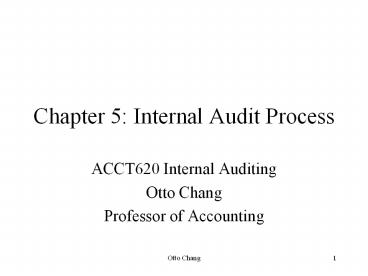Chapter 5: Internal Audit Process - PowerPoint PPT Presentation
1 / 14
Title:
Chapter 5: Internal Audit Process
Description:
Chapter 5: Internal Audit Process ACCT620 Internal Auditing Otto Chang Professor of Accounting Internal Auditing Process Selection of auditee (select riskiest area ... – PowerPoint PPT presentation
Number of Views:457
Avg rating:3.0/5.0
Title: Chapter 5: Internal Audit Process
1
Chapter 5 Internal Audit Process
- ACCT620 Internal Auditing
- Otto Chang
- Professor of Accounting
2
Internal Auditing Process
- Selection of auditee (select riskiest area)
- Audit planning
- Preliminary survey of operations
- Internal control description and analysis
- Expanded tests of control system
- Develop findings and recommendations
- Reporting
- Follow-up
- Evaluation
3
Step 1 Selection Of The Auditee(Chapter 6)
- Audit Plan Based On Risk Assessment (Systematic)
- Ad Hoc Audits
- Auditee Requests
4
Step 2 Audit Preparation (Chapter 7)
- Tentative Overall Purpose and Scope Of Audit
- Review of Previous Audit Files
- Selection of Audit Team
- Preliminary Communication with Auditee
- Preparation of Preliminary Audit Program
- Planning the Audit Report
- Obtaining Approval of The Audit Approach
5
Step 3 Preliminary Survey (Chapter 8)
- Opening Conference
- Tour
- Document Study
- Written Description
- Analytical Review, If Appropriate
6
Step 4 Initial Study of Internal Control
(Chapter 8)
- Controls Description
- Walk-Through of Transactions or Decision Process
- Limited Testing
- Evaluation of Internal Controls
- Risk Assessment
7
Step 5 Expanded Testing (Chapter 9)
- Detailed Review of Operations and Controls
- Tests of Auditors Compliance with Control
Systems - Evaluate Design of Control System
- Evaluate the Effectiveness of Control System
8
Step 6 Findings And Recommendations (Chapter 9)
- Findings
- Conditions actually observed
- Criteria used to evaluate the conditions
- Effects (Risk) of the observed problems
- Cause of the problems
- Recommendations
- No Changes
- Improve Current Controls
- Adding Insurance to Ensure against Risks
- Required Rate of Return to Reflect Risks
9
Step 7 Reporting (Chapter 10)
- Written
- Audit Objectives
- Audit Scope
- General Procedures
- Findings
- Recommendations
- Personal (Oral) Presentation
10
Step 8 9 Follow-Up and Evaluation (Chapter 11)
- Follow-Up
- Auditee Response
- Managements Follow-Up
- Auditors Review
- Evaluation
- Evaluation of Audit Approach, Techniques, Etc.
- Auditor Performance Reviews
11
An Outline of Audit Working Paper
- 1. Table of contents
- 2. Planning checklist
- 3. Authorization form
- 4. Preliminary memo to the auditee
- 5. A cross-referenced audit report, imterrim
memoranda, and follow-up report - 6. Auditees written response to audit findings
and recommendations
12
Audit Working Paper-continued
- 7. Review notes on the working papers
- 8. Audit program
- 9. Summary finding sheets (Chapter 9)
- 10. Preliminary survey
- A. Minutes of opening conference
- B. Summary of observations made during the
on-site tour - C. Notes from study of background materials
- D. Written descriptions of the auditees
operation - E. Analytical review worksheet
13
Audit Working Paper--continued
- 11. Review of Internal Control
- A. Completed internal control questionnaires
- B. Flowcharts and descriptions of internal
control - C. Work sheets on limited tests
- D. Internal control matrix
- 12. Worksheet from expanded tests
- 13. Miscellaneous papers
- 14. Follow-up working papers
14
Format of Working Paper
- Title
- Preparer and reviewers date and initials
- Complete cross-indexing
- Use of tick marks
- Explanation of legends
- Auditors conclusion and recommendation































